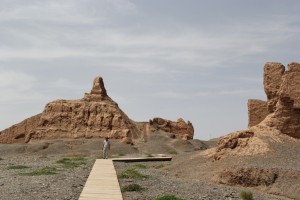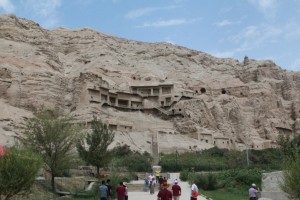Along Shokan Ualikhanov’s Caravan Track, an educational expedition organised by the National Geographic Society and dedicated to the 180th anniversary of the scholar’s birth, came back to Kazakhstan on Aug. 6. National Geographic Society representatives, as well as Ordenbek Mazbayev, a professor at Gumilyov Eurasian National University, Smailzhan Iminov, a researcher of Ualikhanov’s expeditions, a Tengrinews.kz reporter and CTB TV channel cameraman, flew to Urumqi, China on July 24 to start the expedition.
 The route included the cities of the Great Silk Road Ualikhanov visited 155 years ago while traveling to Kashgaria, China. During 12 days, the expeditionists went by vehicle to territories in China and Kyrgyzstan, visiting Urumqi, Karashahar, Korla, Kuchar, Aksu, Kashgar, Artush, Yangisar, Yarkend, Kagalyk, Hotan, Kashgar, Turagat, Naryn, Tash-Rabar and Bishkek.
The route included the cities of the Great Silk Road Ualikhanov visited 155 years ago while traveling to Kashgaria, China. During 12 days, the expeditionists went by vehicle to territories in China and Kyrgyzstan, visiting Urumqi, Karashahar, Korla, Kuchar, Aksu, Kashgar, Artush, Yangisar, Yarkend, Kagalyk, Hotan, Kashgar, Turagat, Naryn, Tash-Rabar and Bishkek.
The expedition participants collected materials about the history, geography, etnography, and linguistics of Kashgaria and learned the routes of Ualikhanov, Marco Polo, Nikolay Przhevalsky, Karl Mannerheim, Gunnar Jarring and Yuri Rerikh.
According to Director of the Kazakh Institute of Geography Akhmetkala Medeu, the expedition gave the opportunity to inquire about changes that took place in population composition, natural conditions and lifestyle throughout the centuries.
“The expedition to Kashgaria is a very interesting project. We have to learn the territory of our neighbours in order to understand them better,” explained Medeu.
The head of the expedition Smailzhan Iminov said that despite the fact that Ualikhanov finished his expedition more that 150 years ago, this region still remains unknown and less explored and a lot of secrets have to be exposed.
“Kashgaria was always a mysterious land. A lot of researchers of that time wanted to discover it. Ualikhanov spent five months there and despite the fact he wrote a book about his journey, a lot of facts remain to be unveiled. We will visit the cities that were poorly decribed,” said Iminov.
Candidate of geographical sciences Kadyr Musa said that he collected a lot of useful data about landscape changes.
“This is a unique route. We passed through ridges, intermontane valleys and gorges. The landscape has changed dramatically, I should say. Some of the rivers dried out or changed their streamway,” said Musa.
Biologist and regional ethnographer of the Eurasian National University Zhashayir Karagoizhin noted that plants described by Ualikhanov can still be found. However, the climate has changed in some parts of the region, so we can assume that Ualikhanov saw another kind of nature concerning flora and fauna. New types of plants have emerged. For instance, expeditionists noticed dog roses in the Kyzyl Yar canyon, which are not typical for the region.
 “I think it was a successful trip. I could only imagine how challenging it was for Ualikhanov to complete the expedition. It was snowing heavily when we were climbing up the mountains and as we know, the Ualikhanov expedition took place in the fall and the return trip was organised in March. Moreover, he was only 22 years old. Despite the young age he created a great treatise which is highly valued in the history of orientalism,” explained Iminov.
“I think it was a successful trip. I could only imagine how challenging it was for Ualikhanov to complete the expedition. It was snowing heavily when we were climbing up the mountains and as we know, the Ualikhanov expedition took place in the fall and the return trip was organised in March. Moreover, he was only 22 years old. Despite the young age he created a great treatise which is highly valued in the history of orientalism,” explained Iminov.
The expedition also had a tourism purpose. Researchers noted that Central Asia has a lot of interesting places for discoverers. Collected materials will be used in the project called Central Asian Golden Ring, which is aimed to unite touristic opportunities of the Central Asian states together with China.
Ualikhanov, who decided to participate in the expedition in 1858, passed the route as part of the merchant’s caravan. He traveled in a mask as a merchant named Alimbay. After 11 months, he came back to Verny (now Almaty) and wrote a report, “About Altynshar condition or about six oriental cities of the Chineese province Nan Loo (1858-1859)”. The treatise was highly appreciated by Russian orientalists and soon after was republished in English.


